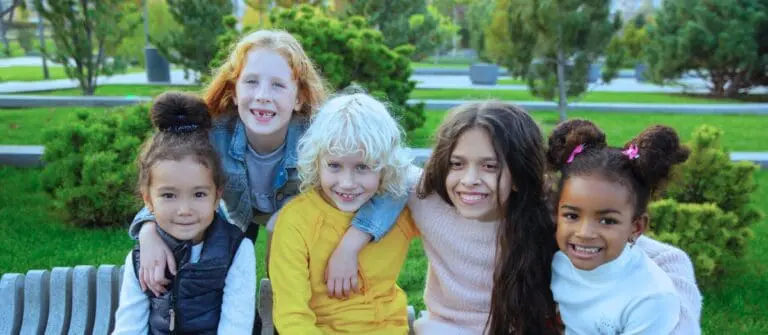TOPLINES:
- Every issue is a children’s issue.
- Investing in children not only increases their immediate well-being, it produces stronger outcomes for their future, families, and our society at large.
- During the pandemic, the federal government came together to increase support for kids and shine a light on many long-standing issues they faced. Unfortunately, many of those programs have expired, but the challenges persist. We must continue to keep kids at the forefront of our work.
- The unique needs of kids must be considered in all policy decisions. Applying an ‘is it good for children?’ test would help guide stronger policy for all.
- Too often, children get left behind in policy and budget discussions; even in ‘child-specific’ policy, their needs can become secondary. For example, debate surrounding the Child Tax Credit has shifted to administrative or other concerns and removed the focus from the benefits we know an expanded, fully refundable credit would bring to children.
INVEST IN CHILDREN:
- Prioritize children in Fiscal Year (FY) 2025 budget decisions and reject the May House Appropriations Committee-passed FY 2025 non-defense discretionary spending level that leaves at least $75 billion in investments on the table that could support children’s healthy development, safety, and well-being.
- Reject arbitrary budget caps, which harm kids. Research has shown robust investments lead to positive near- and long-term outcomes that benefit children, their families, and our communities. These investments also are well-supported by the public.
- Reject future budget caps and approach tax reform in a manner that supports investments in our children, their families, and communities.
IMPROVE THE TAX CODE FOR CHILDREN AND FAMILIES
Problem:
- The enhanced Child Tax Credit (CTC) in 2021 cut child poverty nearly in half, lifting nearly 3 million children out of poverty. However, the expiration of the enhanced CTC left behind almost a quarter of U.S. children, disproportionately affecting infants, toddlers, children of color, children in rural areas, and those in larger families.
Solutions:
- Make Child Tax Credit Improvements Permanent
- Expand the Child Tax Credit (CTC) to provide greater financial support to families and children, including newborns.
- Make the CTC fully refundable to ensure low-income families benefit fully.
- Adjust the credit annually for inflation and provide a monthly delivery option.
- Eliminate Baby and Child Penalties in the Tax Code
- Remove penalties in the tax code that disproportionately affect families with young children.
- Simplify tax filing processes to ensure families can easily claim their benefits.
- Expand the Child and Dependent Care Tax Credit to provide greater financial support to families and make the credit fully refundable to reach low-income households.
- Expand the Earned Income Tax Credit for both households with children and those who are childless workers, ensuring that youth who experience the foster care system and homelessness are eligible for the improved credit at age 18.
CUT CHILD POVERTY
Problem:
- Child poverty negatively impacts every aspect of children’s lives and costs the U.S. up to $1.1 trillion annually.
Solutions:
- Improve the Child Tax Credit
- The federal government should improve the tax code for children and families, particularly the Child Tax Credit.
- Commit to Cut Child Poverty
- Establish a national child poverty reduction target to increase accountability and maintain a commitment to ending child poverty, similar to targets in the UK and Canada.
- Implement a monitoring system to track progress and hold policymakers accountable.
- Reform AFDC
- Modernize the Aid to Families with Dependent Children (AFDC) program and make child poverty reduction a goal of the program.
- Increase benefits and expand eligibility to ensure comprehensive support for struggling families.
IMPROVE CHILD HEALTH AND SAFETY
Problem:
- Millions of children are losing access to health care, with more than 5 million losing Medicaid since protections expired last year and reversing progress made toward ensuring all children have health insurance.
- The Children’s Health Insurance Program (CHIP), crucial for children’s coverage, is not permanently funded.
Solutions:
- Ensure all children have access to affordable, comprehensive health coverage.
- Make the Children’s Health Insurance Program (CHIP) permanent to ensure that health coverage for millions of children is protected and stable in the future.
- Improve Medicaid funding and coverage and oppose efforts to arbitrarily cap or limit the program (i.e., block grants and per capita caps).
COMBAT INFANT AND MATERNAL MORTALITY
Problem:
U.S. infant mortality rates are higher than in other wealthy countries and recently rose for the first time in decades, and maternal mortality rates, especially among Black women, are rising and remain unacceptably high.
Solutions:
- Increase federal investments in programs supporting babies, toddlers, and their families.
- Support comprehensive prenatal and postnatal care and services.
- Mandate 12 months of postpartum coverage under Medicaid.
- Implement programs to reduce infant and maternal mortality rates, especially among marginalized communities.
IMPROVE CHILDREN’S MENTAL HEALTH
Problem:
The mental health crisis is severely impacting children, with increased rates of suicide and decreased access to mental health care.
Children wait an average of 11 years between the onset of mental health symptoms and treatment.
Solutions:
- Expand the pediatric mental health workforce and enforce the mental health parity laws.
- Support school-based mental health programs and youth-led peer crisis intervention services.
- Expand mental health services for children, including school-based programs.
- Increase funding for mental health professionals in schools.
ADDRESS GUN SAFETY
Problem:
Firearms are the leading cause of death in children.
Solutions:
- Implement stricter gun safety laws to protect children from gun violence.
- Promote safe gun storage practices.
- Improve Systems of Health Care for Children
Problem:
Children are not little adults and have unique health care needs.
Solution:
Improve attention to children’s unique and specific health care needs, including access to pediatric emergency care and trained specialists with appropriate equipment to serve the full array of pediatric services appropriately.
EXPAND AFFORDABLE AND ACCESSIBLE EARLY CHILDHOOD PROGRAMS
Problem:
- Access to early childhood programs is limited and unequal, particularly for Black, Hispanic, and low-income families.
- Childcare workers are underpaid, affecting the quality of care.
Solutions:
- Increase funding for childcare subsidies.
- Expand access to high-quality early childhood programs like Head Start, Early Head Start, the
- Child Care and Development Block Grant, and home visiting.
- Implement universal childcare and pre-K programs.
- Ensure early childhood professionals are adequately compensated and respected.
Create Paid Family Leave
Problem:
The United States is the only wealthy nation in the world that does not have a national paid family leave program.
Solutions:
- Implement a national paid family leave program that provides at least 12 weeks of paid leave.
- Ensure coverage for all types of family leave, including parental, medical, and caregiving.
PROVIDE EQUITABLE EDUCATION FUNDING
Problem:
- Federal education programs, such as Title I and the Individuals with Disabilities Education Act (IDEA), have never been fully funded, leaving schools under-resourced.
- Book bans and censorship disproportionately affect diverse experiences, undermining students’ educational opportunities.
- The school voucher movement has been stripping money from our public education system across the country.
Solutions:
- Full and More Equitable Funding of Our Public Schools
- Ensure equitable and more robust distribution of funding to schools by fully funding Title I and IDEA to support low-income students and students with disabilities.
- Invest in school infrastructure and technology.
- Support teacher training and development.
- Support whole-child policies, including school-based health centers and community schools.
- Oppose Public School Privatization and Cultural Wars
- Support our nation’s public schools and oppose the voucher movement, which diverts funds from public schools and lacks accountability.
- Oppose book bans, censorship of curriculum, speech codes, and other cultural wars from being infused into our nation’s public schools.
ELIMINATE CHILD HUNGER
Problem:
- Food insecurity, which declined during the pandemic, is rising again. An estimated 1.54 million students cannot afford school meals.
- One-in-seven children don’t have enough to eat, affecting their ability to learn and thrive. No child should go to bed hungry.
Solutions:
- Expand access to free and reduced-price school meals.
- Increase eligibility for SNAP and ensure WIC receives sufficient funding.
- Ensure year-round food security for children through summer and after-school meal programs.
REDUCE CHILD AND FAMILY HOMELESSNESS
Problem:
- Families with children face higher eviction rates, causing instability that affects health, education, and development.
- Homeless families often struggle to qualify for rental assistance due to restrictive definitions of homelessness.
Solutions:
- Increase funding for affordable housing programs and services and programs focused specifically on child and youth homelessness.
- Provide rental assistance to low-income families with children and youth who experience the foster care system and homelessness.
- Increase support for eviction prevention efforts.
- Use the Department of Education’s definition of homelessness to ensure students in unstable living situations are recognized.
- Address homelessness among children and families through targeted support services.
ELIMINATE CHILD ABUSE AND NEGLECT
Solutions:
- Prevention-Oriented Approaches
- Invest in preventive services to reduce child abuse and neglect.
- Support family strengthening programs.
- Troubled Teen Industry Reform
- Regulate and oversee residential treatment programs for teens to ensure safety and well-being.
- Implement standards of care and accountability measures.
ADDRESS THE NEEDS OF CHILDREN WITHIN U.S. FOREIGN ASSISTANCE
Problem:
- Despite making up a significant portion of the global population, children receive a disproportionately small share of foreign assistance.
- According to UNICEF, children are more likely to live in poverty than adults and more vulnerable to its effects.
- In addition to shortening their life spans, absolute poverty inflicts sickness and suffering on children that stunts the growth of their bodies and brains — robbing them, their families and their nations of their full potential.
- According to a report in The Lancet, “a staggering 43 percent of children under five years of age — an estimated 250 million — living in low- and middle-income countries are at risk of suboptimal development due to poverty and stunting.”
- Global challenges such as COVID-19 and other diseases, climate change, and armed conflict threaten progress in child health and development.
Solutions:
- Increase Overall Support and the Share of Funding to Children
- Expand funding for children in foreign aid programs, prioritizing their holistic needs in health, education, and protection.
- Global Child Advocacy
- Promote policies that support children globally, including in areas of conflict and poverty.
- Collaborate with international organizations to advance children’s rights and well-being worldwide.
MAKE CHILDREN A PRIORITY ACROSS SYSTEMS OF GOVERNMENT
Problem:
Children are often an afterthought to policymakers across government, including the executive, legislative, and judicial branches of government.
Solutions:
- Establish a dedicated White House Office of Children to coordinate child-focused policies.
- Cross-Agency Priority (CAP) at OMB
- Create a Children’s Policy Analysis Unit within the Office of Management and Budget to assess the impact of budget decisions on children.
- Appoint a national Children’s Commissioner to advocate for children’s rights and well-being.
- Require Child Impact Statements for all new legislation and policies to assess their effect on children.
- Ensure that all policies and programs prioritize the Best Interests of the Child.
This Children’s Opportunity Agenda underscores the urgent need for sustained and targeted investments in children to secure a brighter future for them and for society. By addressing these critical areas, policymakers can ensure that every child has the opportunity to thrive.
For more information about these issues, please refer to First Focus Campaign for Children’s Children’s Agenda, created for the 118th Congress.

